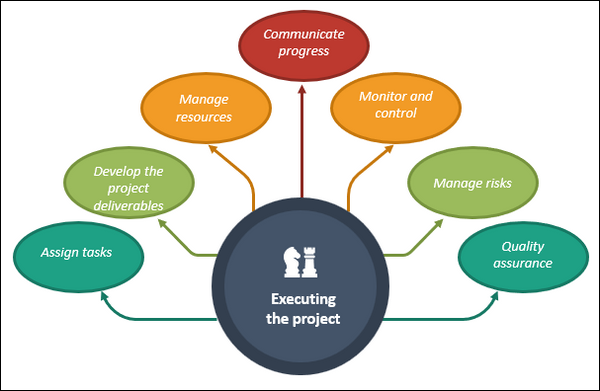The Stages Of Milestone Project Management
Milestone project management is a methodological approach that enables project managers to achieve sustainable success by breaking down larger project goals into smaller and more manageable objectives. This process involves identifying crucial milestones that must be accomplished throughout the course of a project.
Each milestone is a vital step that will ultimately lead the project to its successful completion. The stages of milestone project management include initiation, planning, execution, monitoring, and completion, and each of these stages plays a pivotal role in ensuring the project's success. In this article, we will take a closer look at each stage and the steps involved in achieving project success.
Defining The Project’s Goals And Objectives
Goals:
- To understand the concept of milestone project management and its importance in achieving organizational goals.
- To identify the stages involved in milestone project management and the key activities performed in each stage.
- To develop a comprehensive understanding of the tools and techniques used in milestone project management.
- To improve the project management skills of the team members and enhance their ability to successfully execute projects.
Objectives:
- To define the concept of milestone project management and explain its significance in project success.
- To identify the different stages involved in milestone project management, including initiation, planning, execution, monitoring and control, and closure.
- To describe the key activities performed in each stage and the importance of each activity in achieving project success.
- To explore the various tools and techniques used in milestone project management, such as Gantt charts, PERT diagrams, critical path analysis, and risk analysis.
- To provide hands-on experience in using these tools and techniques through practical exercises.
- To develop project management skills among team members by providing training on project planning, scheduling, monitoring, and communication.
- To develop a project management framework that can be applied to different projects within the organization, leading to improved project execution and successful completion.
Planning The Project :
- Define the scope of the project: Determine what the project is going to accomplish, and what its limitations are in terms of schedule, budget, and resources.
- Identify the stakeholders: Determine who will be impacted by the project, who will be involved in its development and who will have an interest or influence in its outcome.
- Develop a project plan: Create a detailed plan that includes project goals and objectives, timelines, milestones, budgets, resources, risks, and contingency plans.
- Assemble the project team: Identify the resources required to carry out the project and assemble a team comprising internal and external stakeholders with the required knowledge and skills.
- Assign roles and responsibilities to team members: Define the roles and responsibilities of each team member and provide clear expectations of their contribution to the project.
- Establish communication channels: Set up regular communication channels that allow for ongoing collaboration between team members and stakeholders.
- Identify and mitigate risks: Identify potential risks that could pose a threat to the project and develop strategies to mitigate them.
- Monitor and track progress: Monitor and track the progress of the project against the project plan and make necessary adjustments to the plan if required.
- Conduct regular status meetings and reporting: Schedule regular meetings to review project status and progress and provide status reports to stakeholders.
- Evaluate the project: Once the project is completed, evaluate its outcomes against project goals and objectives, and identify lessons learned for future projects.
Executing The Project :
- Assign tasks: Each team member is assigned tasks based on their strengths and expertise. The project manager communicates the assigned tasks to the team members and keeps them updated on any changes.
- Develop the project deliverables: This is where the team starts working on the project deliverables according to the project plan. The project manager monitors the progress to ensure that the project is running on track.
- Manage resources: The project manager manages the project resources, including the budget, people, equipment, and materials. They ensure that the resources are allocated effectively to complete the project on time and within the budget.
- Communicate progress: The project manager communicates the project progress to stakeholders, including the project sponsor, team members, and clients. The communication should be regular to keep everyone updated on the project status.
- Monitor and control: The project manager ensures that the project is carried out within the budget and timeline. They also monitor the quality of work and make necessary changes when required.
- Manage risks: The project manager identifies the potential risks and develops a risk management plan to mitigate them. This is an essential step to ensure that the project runs smoothly without any hiccups.
- Quality assurance: The project team ensures that the project deliverables meet the required quality standards and that the project objectives are achieved.
Monitoring And Controlling The Project :
- Develop project metrics: Before starting the project, establish clear metrics to ensure that you are keeping track of important aspects such as cost, schedule, and quality.
- Monitor project progress: Regularly track progress against project metrics to identify any issues or potential roadblocks.
- Identify and analyze variances: Analyze any variances from the project plan and understand the root cause of any issues that arise.
- Make necessary adjustments: Take corrective actions to bring the project back on track such as re-allocating resources, re-prioritizing work, revising the project schedule, etc.
- Communicate progress: Share project progress with stakeholders to ensure that everyone is aware of any issues and changes in the project.
- Validate deliverables: Ensure that all deliverables meet the project's quality standards and requirements.
- Manage stakeholders: Manage stakeholder expectations by keeping them informed about progress and getting their buy-in on any changes.
Monitoring And Controlling The Project :
- Verify that project deliverables have been completed and meet requirements.
- Conduct a final review of project documentation to ensure all project work is accounted for and properly documented.
- Verify that all project expenses are accounted for and that all invoices have been paid.
- Communicate project closure to all stakeholders and seek feedback for future improvement.
- Archive all project documentation and records for future reference.
Conclusion
In conclusion, understanding the stages of milestone project management is crucial for a project's success. Each stage plays a significant role in ensuring the project is completed on time, within budget, and with high quality. Starting with project initiation and continuing through planning, execution, monitoring and control, and finally, project closure, project managers must be diligent in their approach to each stage. Effective communication, risk management, and team collaboration are critical components of milestone project management. By following these stages and leveraging the right tools and techniques, project managers can deliver successful projects that meet stakeholder expectations and have a positive impact on the organization.





